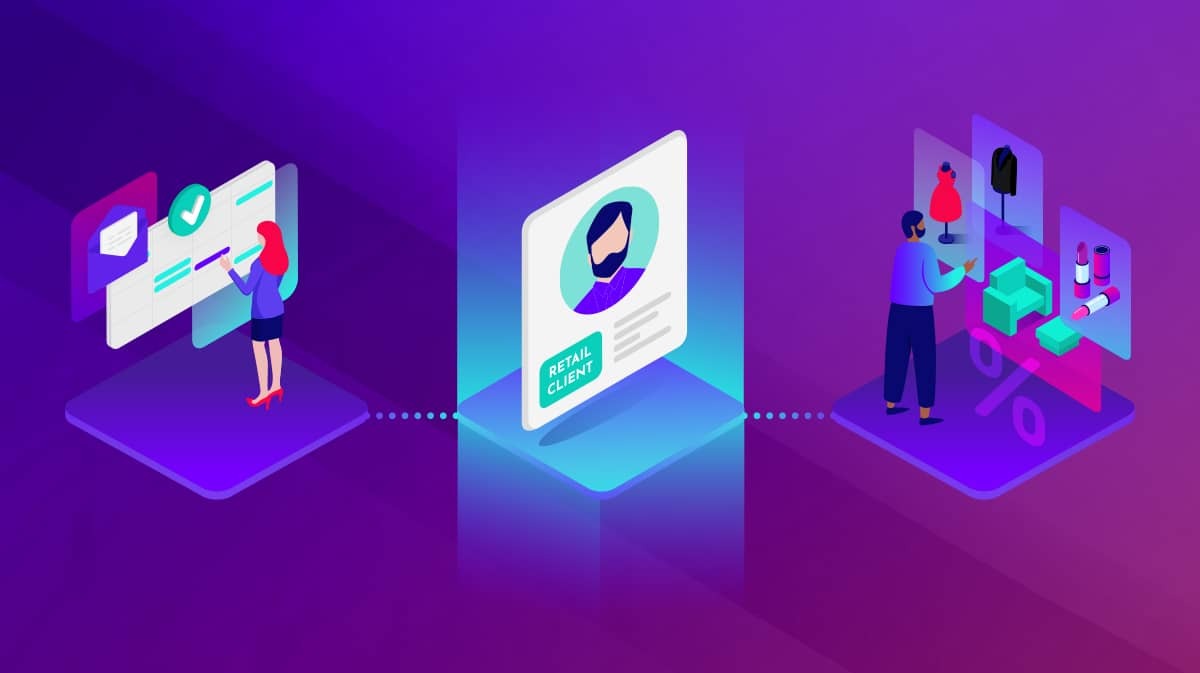How to increase sales with omnichannel technology
Previously, businesses tended to think of online sales and brick-and-mortar sales separately. But using an omnichannel approach that leverages online and in-store sales together can lead to higher sales and profitability.
Below, you'll learn about some new retail traffic solutions and we'll discuss how you can track this traffic. You'll also find guidance on top solutions for increasing retail traffic. By acting on this information, retail businesses can boost sales, even in the era of social distancing.
New technologies to increase retail traffic and sales
If your business has a strong online presence, it’s important to offer options designed to drive customers back to brick-and-mortar stores. Retail traffic in physical stores tends to increase customers’ basket size from three to ten times. According to a First Insight Report, 71 percent of shoppers spent at least $50 more while shopping at physical stores rather than online stores.
Physical stores also encourage human experiences. Impulse buying and human connection often have a strong impact on consumers’ decision-making. For instance, 64 percent of customers in a recent survey indicated they were more likely to make a purchase or invest in a service after an in-person meeting. So if you want to boost sales, driving traffic to retail locations is crucial. Since customers have become more accustomed to shopping online, it’s important to be strategic in evaluating retail traffic solutions. q
Make sure your website runs smoothly
Technology can play a significant role in driving customers into retail stores. A well-designed website can prepare a customer for their in-store experience. It allows them to research products and prices, learn about special offers, and find a physical location. One study found that 82 percent of smartphone users research products while in a physical store. Because of this, providing easily accessible, mobile-friendly information on your website can help improve the customer experience.
Use appointment booking to create a personal shopping experience
Allowing customers to book individual, socially distant appointments is another effective strategy to increase retail traffic. Many retailers are increasingly relying on one-on-one appointments to manage and boost sales during the pandemic. In addition to increasing consumer safety, one-on-one appointments (either in-person or virtual) can help increase sales of big-ticket items. Turn to appointment scheduling software to help your business add a human connection that increases sales.
Use queue management software to reduce waiting times
Managing lines and wait times is also crucial to improving the in-store experience—as well as maintaining necessary social distancing measures. For over thirty years, Professor Richard Larson of the Massachusetts Institute of Technology (MIT), known as “Dr. Queue,” has studied the psychology of waiting. He finds that distraction and expectations are often more important than actual waiting time. His research concludes that, on average, people overestimate how long they’ve waited in a line by about 36 percent. Dynamic queuing software can reduce wait times, manage people counting, and allow customers to manage expectations and continue shopping as they wait.
Queue management software does more than just manage lines. It also allows you to track, analyze, and adapt to customer behavior. Using technology to track a customer’s past purchases, current preferences, and other metrics can help sales representatives custom-tailor each client’s in-store visit. As Cisco reports, 44 percent of businesses that use customer data and retail analytics have seen a boost in sales. When trying to increase sales, it’s particularly important to identify which of your customers spend the most so you can build on their brand loyalty.
In addition, as retail businesses adapt while emerging from COVID-19 stay-at-home orders, tracking peak visit times and managing customer store traffic data are critical.
How to track and manage your retail traffic
If you want to grow your in-store foot traffic, it’s not enough to simply track your sales figures and hope for the best. Luckily, there are a range of analytics tools at your disposal that enable you to optimize and improve sales and profitability.
For instance, retailers know about the importance of holiday season sales. But you’ll want to take a deep dive into other seasonal variations in your traffic. Ask yourself questions like:
- What products are popular in summer?
- Are there surprising months when there is more foot traffic in your retail store?
- Will the easing of COVID-19 restrictions lead to an unusual off-season bounce?
Traditional metrics and tracking
The classic metrics of foot traffic, average selling price, and average basket size can tell retailers how strong their sales are, and the effectiveness of their marketing campaigns. Conversion rates are another powerful metric. Additionally, footfall management solutions can help businesses determine the ratio of visitors to staff or visitors to square footage in their stores. People counting solutions also have an added benefit during current times, and ensure low store densities so customers can shop safely.
Game-changing revolutions in the retail industry, such as the impact of online shopping and COVID-19 restrictions, are reshaping approaches to traditional metrics. A traditional conversion rate measures the number of sales per customer who enter a store. But oftentimes a shopper only makes the decision to buy online after visiting a physical store. Tracking how customers travel and shop within a retail location is crucial to understanding changing patterns of customer behavior.
Important metrics during times of social distancing
One key metric to track during the coronavirus pandemic is the ratio of customers who book appointments online versus those who are walk-ins. According to CNBC, curbside pickups have surged 208 percent during the coronavirus pandemic. So you’ll want to make sure that you accurately track those sales and find ways to keep them returning.
Similarly, line wait times are a critical metric during social distancing: customers want lines to meet COVID-19 guidelines and move efficiently. Queue management solutions can help you identify strategies to efficiently manage lines and keep customers happy and shopping while they wait.
Occupancy levels are also especially relevant these days. Before social distancing, a crowded store—while perhaps a nuisance—wasn’t something you absolutely had to avoid. Now, it’s essential. But even before COVID-19, retailers recognized that consumers behaved differently in a crowded store, sometimes avoiding impulse buys or spending less time shopping.
New tracking tools
As retailers have new metrics to track, they also have new tools at their disposal. These tools help retailers measure how and where customers shop and move around their stores.
Prism Skylabs, for example, has created software that uses video and “heat maps” of customer foot traffic to identify which areas of a store people visit most—and which they neglect or ignore. These sorts of metrics can help you better plan store layout. When you know which areas are neglected, for example, you can use popular items to drive traffic to these spots.
In the era of COVID-19, many retailers are already radically shifting store layouts. For example, many are creating enhanced online-order-and-pickup areas and expanded back rooms. Additional attention to store layout can help boost foot traffic and sales.
It is especially important that retailers are taking action to boost retail traffic and sales. But you also want to make sure you are doing so safely. By closely monitoring metrics, you can ensure you’re meeting social distancing guidelines while encouraging customers to visit your retail business.
Top solutions for retail traffic management
Once you’re tracking your existing customer traffic, you can analyze that data and test new strategies that put this information to use with the goal of increasing retail store traffic. Think of testing and refining these strategies as an ongoing process of learning what your business does well, what doesn’t perform (and needs to be left behind), and areas that show potential but need to be improved.
Leveraging social media
Social media—including Facebook, Twitter, Instagram, and TikTok—serve as great platforms for testing new marketing campaigns and special offers. If a key demographic of your customers is under twenty-five years old, TikTok is where you’ll want to test fun, participatory contests and content. Facebook, with 2.5 billion active users, also continues to be a powerful tool to market to customers. Just be sure you take steps to ensure your social media campaign stands out.
The value of social media for retailers is not limited to testing out marketing campaigns and special offers, however. Social media channels also offer great ways to build brand loyalty, create a community among your customers, and generate excitement for in-store events.
Hosting special events
Those special events— whether exclusive wine tastings, advance previews of new products, or an invitation-only holiday experience—can set your business apart from others, according to research by the US Small Business Administration. Look at your retail store’s traffic data to find downtimes. Then, use those to schedule in-store (or virtual) events. In addition, explore your retail analytics to find your highest-end customers and target them with invitation-only VIP events to improve customer loyalty and ensure they continue to return.
Innovative retailers are sponsoring creative interactive events such as a Stranger Things Halloween experience to draw customers into physical stores. Athletic footwear retailer Fleet Feet has responded to COVID-19 restrictions by shifting its one-on-one appointments with experts to video conferencing. This has allowed customers to get a personalized assessment of their running gait and find a customized shoe fit. As you consider hosting special events, be sure to keep in mind that using an enterprise event scheduling system can help you safely manage these interactions with your customers.
Responding to changing customer patterns and preferences
Footfall analysis is important in the era of social distancing requirements. As you attempt to grow retail foot traffic, you’ll need to carefully plan, and distribute those customers. Prioritize appointments and online-order-and-in-store-pickup options, and plan events during slow retail times. Analyze data to determine which products customers prefer to order online as opposed to in-store.
Also, keep in mind omnichannel approaches to sales, both online and in-store. Many consumers are comfortable ordering technology hardware (computers, tablets, and phones) online. But certain items customers still prefer purchasing in a physical retail store. For instance, a majority of customers report that they like to see what they’re buying in-store when shopping for items like clothing, furniture, and gifts.
Even if a customer eventually buys a product in a physical location, remember that 87 percent of retail purchases begin with online research. Webrooming—in which a customer researches a product online, then purchases in-store, is a growing trend for electronics, clothing, and household items—accounting for 74 percent of in-store sales. Meanwhile, showrooming—where a customer checks out products in-store but then makes the final purchase online—is also a growing trend. Keep a close eye on how your consumers use multiple channels. From there, tailor your customer service, marketing campaigns, and inventory accordingly.
How JRNI can help
Growing retail store traffic is a complicated prospect, especially given all the changes over the past year. But your retail business will be steps ahead by taking advantage of our suite of retail solutions. This powerful enterprise suite includes solutions to facilitate remote appointments, virtual events, and virtual queuing. All of these tools can help you analyze and grow retail sales, and personalize experiences at scale.
Want to learn more? Then sign up time to speak to an expert!




